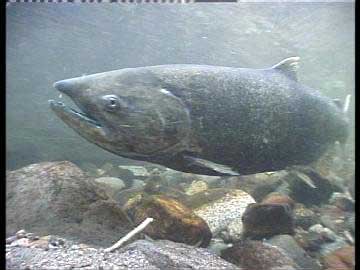Chinook Challenge
Dams, altered habitat reduced genetic diversity of upper Columbia spring Chinook, a species that will not be recovered by supplementation alone, science board says
- February 15, 2018
- John Harrison

The genetic diversity of Upper Columbia spring Chinook salmon, an endangered species, is significantly lower than that of their ancestral stocks, likely in large part because access to much of their historical habitat was blocked by Chief Joseph and Grand Coulee dams. Human development in tributaries, which altered habitat, and the influence of some hatchery programs also played a role. Currently, hatchery supplementation of Upper Columbia spring Chinook is likely staving off extinction, and until habitat conditions can be improved, supplementation by itself will not lead to recovery.
These are among the conclusions of a review of upper Columbia spring Chinook by the Independent Scientific Review Board (ISAB). Eleven scientists serve on the board and advise the Council, NOAA Fisheries, and the Columbia River Indian Tribes on scientific issues. Members of the board are vetted by the National Academy of Sciences and appointed jointly by the Council, NOAA Fisheries, and the Columbia River Inter-Tribal Fish Commission.
Last April, the board’s oversight panel, which represents the three agencies, asked the scientific board to review a habitat assessment, research and monitoring, and prioritization and coordination of recovery actions for spring Chinook salmon in the Wenatchee, Entiat, and Methow rivers of the Upper Columbia River Basin. The purpose of the review was to help strengthen the Upper Columbia River recovery program. This week, the board submitted its review at the February meeting of the Council.
Among other things, the board’s 260-page report said Upper Columbia spring Chinook are not responding to efforts to boost population abundance. The construction of impassable dams, unscreened irrigation diversions and other habitat alterations in the 19th and early 20th centuries plus hatchery programs operating in the early- to mid-20th century evidently altered the genetic diversity and overall fitness of the fish. Ongoing hatchery supplementation programs have not yet increased overall abundance or the number of fish that spawn in the wild. Overall productivity of the species has not changed, the board said.
Other key points of the review include:
- Scientific principles and methods for identifying factors limiting the recovery of the species are generally sound, but to improve the analysis of limiting factors in the Upper Columbia, the board recommended integrating results of freshwater habitat assessments, density dependence analyses, and life-cycle modeling to identify limiting factors across the entire life cycle and geographic range of spring Chinook.
- Upper Columbia spring Chinook may be exposed to greater risks than Snake River spring/summer Chinook because there are fewer populations and fewer fish in the upper Columbia. The board’s concern is consistent with the findings of NOAA Fisheries when the Upper Columbia ESU was originally listed as endangered and the Snake River ESU as threatened, listings that were not changed in the most recent [NOAA status] reviews. The board recommended continued comparison of Upper Columbia and Snake River Chinook recovery through rigorous research, monitoring, and evaluation programs to determine which restoration actions are most effective.
- Differences between spring and summer Chinook in the Upper Columbia could identify limiting factors for spring Chinook. The board recommended continued investigations of the relative performance of summer Chinook and spring Chinook in Upper Columbia and said management actions should be developed to reduce constraints on spring Chinook abundance as information becomes available.
- Evidence indicates that habitat protection is a high priority, followed by removing barriers to migration, and reconnecting floodplains and side channels. It is important to restore processes that maintain channel complexity and supply and retain large wood in rivers, which provide resting and hiding places for juvenile fish. The ISAB recommends that projects that restore and sustain key river and ecological processes should be considered high priority, given predictions for future climate and evidence of past success with this restoration approach. A key goal will be to provide habitats that are resilient to changing conditions and extreme events and provide connected habitats to sustain the full range of life history diversity.
- Contemporary populations of Upper Columbia River spring Chinook exhibit significantly lowered genetic diversity compared with historical stocks, including spring Chinook that once spawned above Chief Joseph and Grand Coulee dams. Straying rates in some hatchery programs are quite high and could erode stock-specific adaptations. In view of the lack of response to supplementation programs in the Upper Columbia, the ISAB recommends that additional studies be performed to try to better understand the factors that are limiting spring Chinook abundance.



